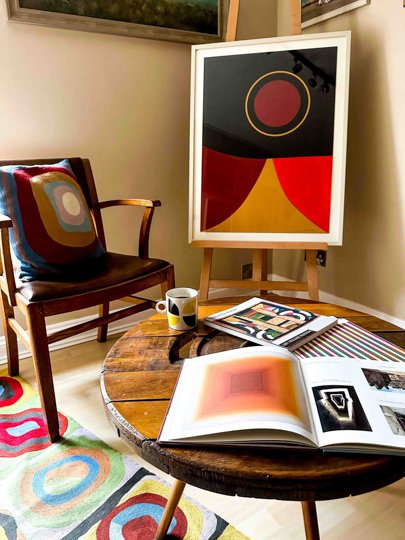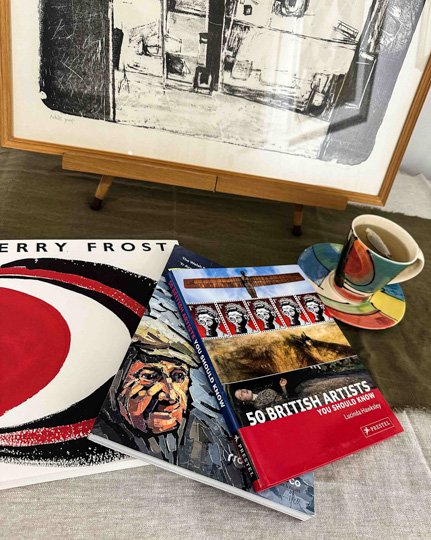Welcome to the Verso Blog - Modern British Art insights and posts
The Story Behind the Painting
Definition of Verso:
Stemming from early Latin roots, the term verso means reverse. In an art context, it refers to the reverse side or back of a picture.
The verso demands a different form of contemplation, as it is that which is not always immediately obvious.
Vuillard's Influence on Paul Lucien Maze Paintings
Édouard Vuillard's influence on Paul Lucien Maze is profound, shaping his artistic journey and style. Vuillard, a post-impressionist master known for his intimate domestic scenes and intricate patterns, inspired Maze to explore the medium of pastels. This encouragement led Maze, who was initially exposed to Impressionist greats like Monet and Pissarro, to develop a distinctive voice in vibrant pastel paintings capturing urban life and landscapes with dynamic energy. Vuillard’s techniques, such as the use of flattened perspectives and bold patterns, can be seen in Maze’s work, enriching his compositions with depth and emotional resonance. Collectors of Maze's paintings can appreciate the depth added by Vuillard’s lasting influence, making each piece a tribute to their intertwined legacies.
British Abstract Painters from 1940 - 2000
The period from 1940 to 2000 witnessed a remarkable evolution in the world of British abstract art, shaped by the creative changes, challenges, and constants. From the post-war period to the swinging sixties and beyond, British abstract artists navigated their own unique paths, pushing the boundaries of abstraction and expanding the possibilities of materials and painting techniques.
As we celebrate the legacy of British abstract painters, let us not forget the contributions of those who played a crucial role in shaping the movement. Their innovative approaches to abstraction and commitment to artistic excellence continue to inspire artists and collectors alike, ensuring that the legacy of British abstract art remains vibrant and enduring for generations to come.
Art as an investment (Love what you buy)
Art as an Investment.
Are you contemplating turning your living room into a potential gold mine with some fancy wall hangings? This blog dives into the artistic abyss of whether art is a savvy investment, steering clear of the mega-rich folks and their art splurges. If you're not swimming in trust funds or recording platinum albums, fear not—this one's for the art-loving Brits on a budget. The blog takes you on a rollercoaster ride through inflation, FTSE 100 trends, and gold's glamorous journey, offering a pinch of humor along the way. But hold your art-loving horses! Paintings don't dole out dividends or interest, and there's a laundry list of hidden costs like buying fees and restoration bills. The blog humorously recounts an auction escapade involving a painting desperately trying not to be a Dutch windmill scene, highlighting the challenge of picking timeless pieces with broad appeal. Whether you fancy British landscapes or communist propaganda art (yes, really), the blog advocates for investing with passion. So, if you're ready to trade your wallet for a paintbrush, this whimsical guide suggests going with what makes your heart skip a beat. Contact Rastall.Art.
Because who needs a financial advisor when you can enjoy some wonderful Art? (Caution - This is not Financial Advice, just wonderful paintings!)
13 Collectable 20th Century British Artists for under £1,000
A search for 20th Century British Artists will throw up all the national treasures (Bacon, Hockney, Sickert, Bell, Grant & John etc.) but without a price filter option for the modest collector.
When searching for affordable artwork, it's easy to stumble upon less desirable paintings featuring donkeys wearing hats. However, fear not! We have curated 13 intriguing 20th Century British artists, with their unique styles, for you to explore. While affordability can be subjective, we have set a maximum budget of £1,000 per picture. Some artists may be unfamiliar, but they are undoubtedly worthy of your consideration.
Fred Yates - Two paintings, One Life: The Crowd & Celebration
Embark on a journey through the brushstrokes of British Artist Fred Yates, whose paintings are a heartfelt expression of his emotions and experiences. In this blog, I delve into the intriguing question: Can we truly grasp the changes in Fred's life by analyzing just two of his mesmerizing artworks?
Fred's early life, shaped by a strict upbringing and the profound loss of his twin brother, fostered his introspective and contemplative nature. However, it was when he broke free from the confines of full-time teaching that the exuberant, playful side of Fred burst forth onto the canvas.
Our private collection proudly showcases 'The Crowd' from 1973 and 'Celebration' from the mid-2000s, nestled side by side, inviting us to witness the remarkable evolution of Fred Yates as both an artist and a man. We consider the emotions woven within these two unique masterpieces and explore the vibrant tapestry of Fred's life and artistic career.
How long do Artists nurture and retain ideas? We consider Sir Terry Frost's work for inspiration
We explore the intriguing question of whether artists retain and nurture their ideas across the years. From the alluring Harvest Moons painting to an untitled sketch on graph paper, Sir Terry Frost's work across decades offer tantalizing clues about the evolution of artistic concepts.
In particular, the image of the Black Sun in Newlyn 1983 with its luminous haze draws viewers into its enigmatic allure through to the striking screenprint 'Red, Ochre & Black' by Frost, a pure form of color and shape that mesmerizes with its simplicity. Could Frost have held onto these ideas for decades, refining and maturing them over time? Join us as we muse on the skill and appeal of Frost's enduring creations.
Mid-Century Abstract Art - Buying and Restoration challenges
Mid-Century Abstract Art is not always perfect, and sometimes it comes with war wounds like scratches, dinks, and even watermarks. The challenge comes when you decide whether to restore it or not. For Tracy, an art lover and gallery partner, the decision was easy when she found a mixed media abstract artwork on card at a Modern British Art auction. Even though the artwork was sun-damaged, had creases, and was stuck to a broken 1970s plastic frame, Tracy fell in love with it and believed it was a hidden gem worth purchasing.
If you're a collector of British mid-century abstract art, this is quite a lovely little find, with an interesting story uncovered by its professional restoration.
Paul Feiler: From Landscapes to Abstractionism, An Artistic Odyssey
Paul Feiler was a British artist known for his contribution to constructivist art. He started his artistic journey with landscapes and later transitioned towards abstractionism. Feiler's approach to constructivist art involved the use of geometric forms, bold colour contrasts, and personal symbolism to create intellectually rigorous and emotionally resonant works. His artwork evolved over time, with his later works showcasing a more refined and harmonious style. Through his artistic odyssey, Feiler's legacy as a master of constructivist art continues to inspire and engage art enthusiasts around the world.
Fred Yates and the Rastall family connection
Much has been written about the artist Frederick Joseph Yates (b1922 – d2008) and thankfully as interest continues to build about this fascinating British painter’s life, more is added. So let me add a small chapter about the connection Fred has had with four generations of the Rastall family.
It starts in Bournemouth where a young Fred Yates was welcomed by my great grandmother Nelly Rastall as a paying lodger, renting a room in her big house in Purbeck Road, Bournemouth, not far from the pier. This must have been after the war around 1946 when Fred signed up for an art teacher training course.
20th Century British Art – How to start your art collection
After a coffee and a chat about Modern British Art, I was asked recently “how do people start their art collection?”. Surely you just start by buying a painting you like?
OK not everyone spends hours obsessively researching 20th Century British Artists on an evening!
So how would we suggest you start collecting, and investing in art by 20th Century British Artists?
Here are some pointers to get you going. Remember you are not going to like everything you see, but eventually something will click, and you should find something that you just love.
Fred Yates ‘Pen and Ink’ Drawing - an unusual commission
Like struggling actors, artists need to keep an income coming in during the early years of a painting career. This can involve unusual commission requests, and for art collectors this can lead to a rare item.
In the early 1970’s Fred Yates found himself back with the Rastall household staying a few days around the Wye Valley with my grandmother. My father was running the family business in Tintern, and asked for Fred’s help with an unusual commission.












